Demo stack/layers
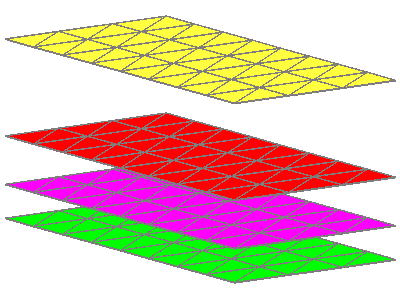
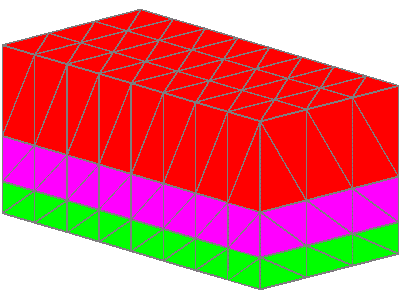
Example 1
no buffers, no refinement, no truncation
STACK TRI LAYERS into cmo name cmo1.
Read 4 AVS triangulated surfaces into 3 materials.
Stack and pinchout if layers cross.
Label material colors with 1 on bottom and 3 on top.
The syntax stack/layers/avs means stack a list of AVS triangle surface files. This is followed by a list of files with integers after each file, the first file in the list is the bottom, the last is the top. The first integer after each file name is the material value for cells between layers. (a second integer would be the refinement number, default is 0)
cmo create cmo1
stack/layers/avs/ &
surf-12.inp 1 / surf-5.inp 2/ surf5.inp 3/ surf25.inp
Screen output:
*******************************************************************
* Example 1
* file: demo_tri_simple.in
* stack/layers
* no buffers, no refinement, no truncation
*******************************************************************
* STACK TRI LAYERS into cmo name cmo1
* read 4 AVS triangulated surfaces into 3 material units
* stack and pinchout if layers cross
* label unit colors with 1 on bottom and 3 on top
* details:
* the syntax stack/layers/avs
* means stack a list of AVS triangle surface files
* this is followed by a list of files with integers after each file
* the first file in the list is the bottom, the last is the top
* the first integer after each file name is the material value
* (a second integer would be the refinement number)
* after the list of surface files, there are command options
* the option "pinch" represents the thinness of a layer before
* it is pinched out. If a layer crosses, the lower surface truncates.
*********************************************************************
cmo create cmo1
stack/layers/avs surf-12.inp 1 surf-5.inp 2 surf5.inp 3 surf25.inp pinch 0.
Layers to create: 4
Max material number: 4
Reading 4 surface files...
................................................................
surface name layer color type llcorner zic
surf-12.inp 1 1 -1 1) -1.200000E+01
surf-5.inp 2 2 0 37) -5.000000E+00
surf5.inp 3 3 0 73) 5.000000E+00
surf25.inp 4 4 -2 109) 2.500000E+01
Elements per layer: 48 total: 192
Nodes per layer: 36 total: 144
STACK DONE: 4 files read out of 4
................................................................
*********************************************************************
* STACK to PRISM to TET
* convert stacked layers in cmo1 into a tet grid named cmotet
* The stacked layers are filled to create a prism grid.
* The prism grid is then converted to a tet grid.
* hextotet will check cmo for mesh type then use hextotet/6
*********************************************************************
stack/fill/cmopri/cmo1/
hextotet// cmotet / cmopri
boundary_components
1 different boundary components identified.
2 is a representative vertex
finish
LaGriT successfully completed
The following commands convert the stacked 2D layers into 3D volumes. In this example, triangles are stacked into prism elements. Each of the prism elements are then converted into 6 tet elements. The command boundary components will check for 1 single boundary.
stack/fill/cmopri/cmo1/ hextotet/6/ cmotet / cmopri boundary_components finish
Screen output:
1 different boundary components identified. 2 is a representative vertex
Example 2 Reverse Material Colors
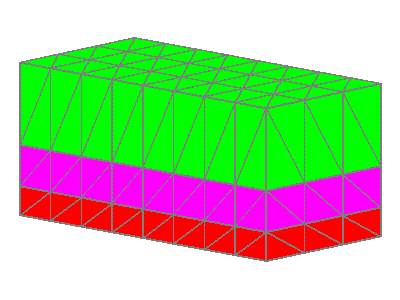
Stack/layers with material colors reversed.
Material 1 (green) is now the top unit. Material 2 (purple) is middle and 1 (red) is bottom.
The unit value was changed from above example on the command line:
cmo/create/cmo1 stack/layers/avs/ surf-12.inp 3/ surf-5.inp 2/ surf5.inp 1/ surf25.inp 1
Screen output:
cmo create cmo1
stack/layers/avs surf-12.inp 3 surf-5.inp 2 surf5.inp 1 surf25.inp 1
................................................................
surface name layer color type llcorner zic
surf-12.inp 1 3 -1 1) -1.200000E+01
surf-5.inp 2 2 0 37) -5.000000E+00
surf5.inp 3 1 0 73) 5.000000E+00
surf25.inp 4 1 -2 109) 2.500000E+01
Elements per layer: 48 total: 192
Nodes per layer: 36 total: 144
STACK DONE: 4 files read out of 4
................................................................
Example 3 buffered
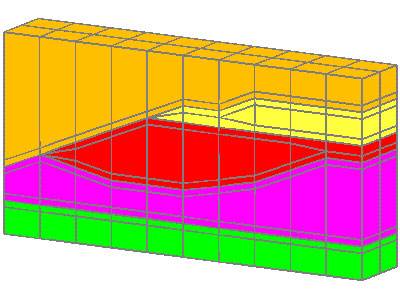
Stack quad layers and fill with hex elements, with buffered interfaces.
Read 6 AVS quad surfaces into 5 material units.
Label unit colors with 1 on bottom and 5 on top.
Stack and pinchout if layers are closer than .19 meters.
Add a buffer layer .2 meters above and below each interface.
Truncate by 5th file to read.
Note the & character added so command line is not too long to read.
cmo/create/cmo1 stack/layers/avs & q-1.inp 1 & q0.inp 2 & qhole.inp 3 & q3.inp 4 & qtop.inp 5 & q5.inp 5 & truncate 5 / buffer .2 / pinch .19 stack/fill/cmohex/cmo1
Screen output:
********************************************************
* file: demo_quad_buffers.in
* stack/layers
* buffers, truncation, no refinement
********************************************************
* STACK QUAD LAYERS into cmo named cmo1
* Read 6 AVS quad surfaces into 5 material units
* label unit colors with 1 on bottom and 5 on top
* stack and pinchout if layers closer than .19 meters
* add a buffer layer .2 meters above and below each interface
* truncate by 5th file to read
cmo create cmo1
stack/layers/avs &
q-1.inp 1 &
q0.inp 2 &
qhole.inp 3 &
q3.inp 4 &
qtop.inp 5 &
q5.inp 5 &
truncate 5 / buffer .2 / pinch .19
................................................................
surface name layer color type llcorner zic
q-1.inp 1 1 -1 1) -1.000000E+00
buffer 2 1 1 34) -2.000000E-01
q0.inp 3 2 0 67) 0.000000E+00
buffer 4 2 1 100) 2.000000E-01
buffer 5 2 1 133) 8.000000E-01
qhole.inp 6 3 0 166) 1.000000E+00
buffer 7 3 1 199) 1.000000E+00
buffer 8 3 1 232) 1.000000E+00
q3.inp 9 4 0 265) 1.000000E+00
buffer 10 4 1 298) 1.000000E+00
buffer 11 4 1 331) 1.000000E+00
qtop.inp 12 5 0 364) 1.000000E+00
buffer 13 5 1 397) 1.200000E+00
q5.inp 14 5 -2 430) 5.000000E+00
Elements per layer: 20 total: 280
Nodes per layer: 33 total: 462
Layers truncated by qtop.inp layer 12
STACK DONE: 6 files read out of 6
STACK DONE: 8 layers created for total 14
................................................................
* STACK to HEX to TET
* convert stacked layers in cmo1 into a tet grid named cmotet
stack/fill/cmohex/cmo1
hextotet// cmotet / cmohex
* CHECK the GRID
* boundary_components should return 1 boundary
* otherwise there are holes in the mesh
quality
boundary_components
Example 4 tri layers to prisms
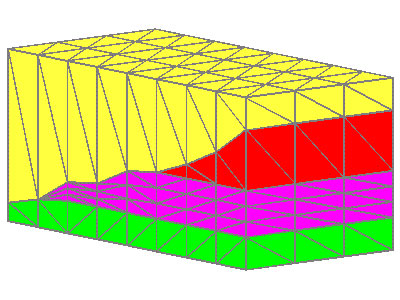

tri layer to prism then to tet with truncating surface and layer refinement.
STACK TRI LAYERS into cmo named cmo1.
Read 5 AVS triangulated surfaces into 4 material units.
Label unit colors with 1 on bottom and 3 on top.
Stack and pinchout if layers cross.
Add two layers for refinement in second unit.
Note layer type attribute: -1 is bottom, -2 is top surface 0 is surface read from file 1 is layer derived between surface at constant distance 2 is layer derived between surface at proportional distance
cmo create cmo1 stack/layers/avs & surf-12.inp 1 & surf-5.inp 2 & surf5.inp 3 2 & surf2_slope.inp 4 & surf25.inp 4 & truncate 4 / pinch 0. stack/fill/ cmopri /cmo1 hextotet // cmotet / cmopri
Screen output:
................................................................
surface name layer color type llcorner zic
surf-12.inp 1 1 -1 1) -1.200000E+01
surf-5.inp 2 2 0 37) -5.000000E+00
refine 3 2 2 73) -1.666667E+00
refine 4 2 2 109) 1.666667E+00
surf5.inp 5 3 0 1) 5.000000E+00
surf2_slope.inp 6 4 0 181) 1.800000E+01
surf25.inp 7 4 -2 217) 2.500000E+01
Elements per layer: 48 total: 336
Nodes per layer: 36 total: 252
Layers truncated by surf2_slope.inp layer 6
STACK DONE: 5 files read out of 5
................................................................
Back to STACK